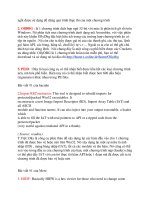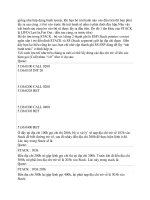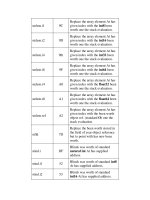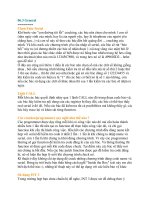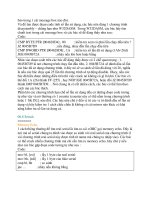Cracker Handbook 1.0 part 48 potx
Bạn đang xem bản rút gọn của tài liệu. Xem và tải ngay bản đầy đủ của tài liệu tại đây (12.62 KB, 6 trang )
Syntax:
CLI
This instruction turns off the interruptions flag, disabling this way
those maskarable interruptions.
A maskarable interruptions is that one whose functions are deactivated when
IF=0.
CMC INSTRUCTION
Purpose: To complement the cartage flag.
Syntax:
CMC
This instruction complements the state of the CF flag, if CF = 0 the
instructions equals it to 1, and if the instruction is 1 it equals it to 0.
We could say that it only "inverts" the value of the flag.
STC INSTRUCTION
Purpose: To activate the cartage flag.
Syntax:
STC
This instruction puts the CF flag in 1.
STD INSTRUCTION
Purpose: To activate the address flag.
Syntax:
STD
The STD instruction puts the DF flag in 1.
STI INSTRUCTION
Purpose: To activate the interruption flag.
Syntax:
STI
The instruction activates the IF flag, and this enables the maskarable
external interruptions ( the ones which only function when IF = 1).
5 Interruptions and file managing
Table of Contents
5.1 Internal hardware interruptions
5.2 External hardware interruptions
5.3 Software interruptions
5.4 Most Common interruptions
5.1 Internal hardware interruptions
Internal interruptions are generated by certain events which come during
the execution of a program.
This type of interruptions are managed on their totality by the hardware
and it is not possible to modify them.
A clear example of this type of interruptions is the one which actualizes
the counter of the computer internal clock, the hardware makes the call to
this interruption several times during a second in order to maintain the
time to date.
Even though we cannot directly manage this interruption, since we cannot
control the time dating by means of software, it is possible to use its
effects on the computer to our benefit, for example to create a "virtual
clock" dated continuously thanks to the clock's internal counter. We only
have to write a program which reads the actual value of the counter and to
translates it into an understandable format for the user.
5.2 External hardware interruptions
External interruptions are generated by peripheral devices, such as
keyboards, printers, communication cards, etc. They are also generated by
coprocessors. It is not possible to deactivate external interruptions.
These interruptions are not sent directly to the CPU, but rather they are
sent to an integrated circuit whose function is to exclusively handle this
type of interruptions. The circuit, called PIC8259A, is controlled by the
CPU using for this control a series of communication ways called paths.
5.3 Software interruptions
Software interruptions can be directly activated by the assembler invoking
the number of the desired interruption with the INT instruction.
The use of interruptions helps us in the creation of programs, and by using
them our programs are shorter, it is easier to understand them and they
usually have a better performance mostly due to their smaller size.
This type of interruptions can be separated in two categories: the
operative system DOS interruptions and the BIOS interruptions.
The difference between the two is that the operative system interruptions
are easier to use but they are also slower since these interruptions make
use of the BIOS to achieve their goal, on the other hand the BIOS
interruptions are much faster but they have the disadvantage that since
they are part of the hardware, they are very specific and can vary
depending even on the brand of the maker of the circuit.
The election of the type of interruption to use will depend solely on the
characteristics you want to give your program: speed, using the BIOS ones,
or portability, using the ones from the DOS.
5.4 Most common interruptions
Table of Contents
5.4.1 Int 21H (DOS interruption) Multiple calls to DOS functions.
5.4.2 Int 10H (BIOS interruption) Video input/output.
5.4.3 Int 16H (BIOS interruption) Keyboard input/output.
5.4.4 Int 17H (BIOS interruption) Printer input/output.
5.41 21H Interruption
Purpose: To call on diverse DOS functions.
Syntax:
Int 21H
Note: When we work in TASM program is necessary to specify that the value we
are using is hexadecimal.
This interruption has several functions, to access each one of them it is
necessary that the function number which is required at the moment of
calling the interruption is in the AH register.
Functions to display information to the video.
02H Exhibits output
09H Chain Impression (video)
40H Writing in device/file
Functions to read information from the keyboard.
01H Input from the keyboard
0AH Input from the keyboard using buffer
3FH Reading from device/file
Functions to work with files.
In this section only the specific task of each function is exposed, for a
reference about the concepts used, refer to unit 7, titled : "Introduction
to file handling".
FCB Method
0FH Open file
14H Sequential reading
15H Sequential writing
16H Create file
21H Random reading
22H Random writing
Handles
3CH Create file
3DH Open file
3EH Close file driver
3FH Reading from file/device
40H Writing in file/device
42H Move pointer of reading/writing in file
02H FUNCTION
Use:
It displays one character to the screen.
Calling registers:
